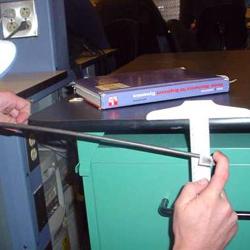Source Institutions
Add to list Go to activity
Activity link broken? See if it's at the internet archive

Learners play the role of materials engineers as they test the flexibility of different materials. They determine the strength-to-weight ratio of bars of these materials (e.g., steel, aluminum, wood, etc.) and discuss the advantages to using each in different scenarios. This activity can serve as a demonstration for younger students.
- 5 to 10 minutes
- 45 to 60 minutes
- $5 - $10 per group of students
- Ages 11 - 14
- Activity, Demonstration, Experiment/Lab Activity
- English
Quick Guide
Materials List (per group of students)
- Bend that Bar Worksheets (one for each student)
- A spring scale (optional), or groups take turns if fewer are available
- 1 bar 15"-18" (38-46 cm) in length and 1/8"-1/4" (3-6 mm) in diameter of each of the following: steel, aluminum, wood, plastic (if available), brass (if available), copper (if available)
- 1 Sharpie® or marker/pens to write on the bars
- Yard/meter stick
- Calculator (optional)
- Bathroom or top-loading scale to weigh individual bars
Subjects
-
Engineering and Technology
-
Engineering
- Architectural Engineering
- Metallurgy and Materials Engineering
-
Technology
- Manufacturing
-
Engineering
-
Mathematics
-
Data Analysis and Probability
- Data Analysis
- Data Collection
- Measurement
-
Data Analysis and Probability
-
Physical Sciences
- Motion and Forces
-
Structure and Properties of Matter
- Mass and Weight
Audience
To use this activity, learners need to:
- see
- read
- touch
Learning styles supported:
- Involves hands-on or lab activities
Other
Includes alignment to state and/or national standards:
This resource is part of:
Access Rights:
- Free access
By:
- Rutkowski, Tom ; Conner, Alex ; Hill, Geoffrey ; Schaefer Zarske, Malinda ; Yowell, Janet
Source Collection
- TeachEngineering
Rights:
- All rights reserved, Regents of the University of Colorado, 2004
Funding Sources:
- National Science Foundation, 0226322
- Fund for the Improvement of Postsecondary Education (FIPSE)
- U.S. Department of Education
